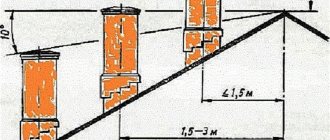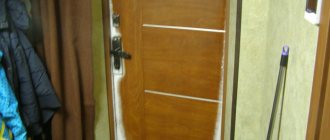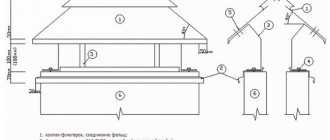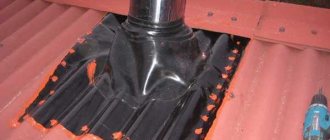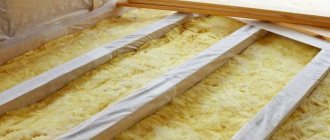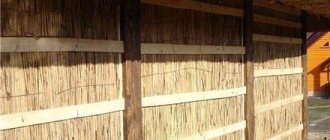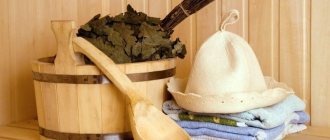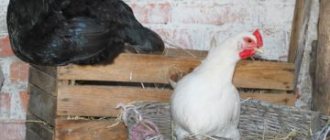Types of insulation that are used to insulate an iron chimney pipe, their use. Advice from experts on the correct assembly of insulating structures, errors that builders make during installation. Necessary devices for thermal insulation of a fireplace chimney, solid fuel, gas internal combustion boiler.
When heating a private house or cottage, it is necessary to insulate the chimney from contact with the ceiling and protect surfaces from fire when it is heated. Creating energy savings, as well as increasing the strength of the chimney duct, requires protecting it from temperature changes and ensuring insulation of the chimney.
Also limit the flow of water along the surface of the channel into the house during rain. The insulation scheme needs to be planned at the beginning of building a house.
Why do you need to insulate a chimney?
To the question: why thermally insulate a chimney, the answer is simple. About 30% of the heat is lost through the thin ceiling and pipe from the heating device.
The outlet from the heating device has two purposes:
- remove vapors and combustion waste (soot, ash, soot);
- provide good traction.
Without insulation, the channel walls cool down quite quickly. Thick resins and soot from combustion settle on cold surfaces. Over time, a large amount of sediment accumulates and the outlet becomes clogged.
This reduces traction, as well as:
- The heating system burns poorly and gives off heat;
- condensation accumulates on the channel walls;
- the internal walls are destroyed;
- Without sufficient draft, smoke accumulates and leaks into the room.
The ventilation duct and chimney, through which combustion residues of a gas boiler are removed, require thermal insulation.
Why insulate a chimney pipe
During operation of a stove heating or gas boiler, their smoke exhaust elements are exposed to the effects of combustion products of varying degrees of acidity and toxicity passing through them. Also, a constantly high temperature difference has a negative impact on pipes, especially in the cold winter months.
In the Russian climate, it is imperative to insulate chimney pipes
The combination of these factors contributes to the fact that:
- Flammable toxic vapors and their oxides condense and solidify on the inner surface of the pipes.
- Slag deposits eat into the walls of the chimney and increase its mass. And excess weight means increased pressure, both on the structure of the pipe itself and on the adjacent parts of the building’s roof.
- The compounds released by smoke, among other things, can corrode the materials from which the pipe is made. With constant use, microcracks form in them, which can subsequently lead to serious damage and even destruction of the entire structure, as, for example, in the case of brick chimneys.
Insulation allows owners of cottage houses to avoid all these troubles. After competently done work, the surface of the pipe will warm up evenly along its entire length, due to which a larger volume of smoke will pass through it without settling on the walls and without destroying the material. This will also increase the strength characteristics of the pipe, and therefore its durability.
It is important! Increasing the thermal insulation of the chimney will also affect the efficiency of the heating system as a whole. An insulated pipe will allow the boiler or furnace to heat up faster, increasing its efficiency while conserving fuel.
Fireplace chimney insulation
A separate clarification on the issue of pipe insulation should be made for owners of decorative stoves and fireplaces. Despite the fact that such systems, as a rule, are used for aesthetic pleasure, and not for constant heating of the room, craftsmen also recommend thermal insulation.
In this case, the main reason for insulating the pipe will not be so much energy efficiency as safety and ease of use.
It is also recommended to insulate the pipes of fireplaces and decorative stoves
Any fireplace, even one that is not used as often as a stationary heat source, must be cleaned regularly after lighting and use. If its chimney is thermally insulated, carbon deposits will form in it less often, which means that the risk that the fireplace will clog will be much less.
Advantages of an insulated chimney
An important stage in designing a warm house is organizing thermal insulation of the exhaust duct inside and outside the house. Vapors and soot adhere to the internal surfaces, combine with condensate, and corrode the internal coatings of the channel.
Modern houses are heated by automatic heating systems that switch over and over again, the system heats up and cools down to a certain temperature. With this mode of operation, condensate and combustion waste become several times larger, which leads to rapid destruction of the smoke exhaust channel.
There is only one way out: find out how to carry out proper thermal insulation, which one to buy and apply the insulating base.
Insulating the chimney will reduce heat loss and help:
- provide good ventilation in the duct;
- get rid of freezing;
- reduce the process of settling of resins and vapors on the canal walls;
- will reduce repair costs and heat loss.
Making thermal insulation with your own hands is not difficult, but the main thing is to know how to insulate a metal chimney pipe or brick duct. For use, there are special non-flammable substances used for household and professional thermal insulation.
The design of an insulated chimney and its features
Insulation of chimney pipes with various materials
The figure shows an example of insulation of a chimney pipe with mineral wool and a galvanized sheet (on the left), and insulation with mineral wool and decorated slag concrete (on the right). This example is considered for a chimney made of asbestos-cement pipe.
A comparative example of how thermal insulation works is shown in the figure, as they say: “Find 10 differences.”
Protective effect of insulation
A layer of insulation material protects the structure from condensation inside and from weathering outside.
How to insulate a chimney inside and outside
Thermal insulation components are heat-resistant, unaffected by temperature changes, resistant to high humidity, and unaffected by mold.
Selected insulation for chimney pipes increases the resistance of the outlet channel to temperature changes and reduces the impact on the roof area around it. To insulate the chimney from the outside, the following are used: concrete buildings, casings and cylinders, wrapped with heat-resistant materials. For internal thermal insulation, expanded clay, perlite, and bulk basalt are used.
produces pierced stone wool mats, sealed with galvanized mesh. It is used for winding pipes and insulating furnaces in boiler rooms, which are heated up to +750°.
Bath chimney
High humidity and high bath temperatures affect the condition of the metal surface. The insulated channels are heated evenly, resulting in increased heat transfer from the furnace.
In conditions of high humidity of the bath, stainless sandwich pipes are used or a ceramic sectional chimney is assembled in expanded clay concrete modules.
Exit from the “potbelly stove”, fireplace, water heater
A portable iron stove is used to heat temporary buildings and dachas. Access to the street is planned first. A square or round opening is cut in the wall, the width of which is calculated as follows: from the walls to the cross-section of the smoke channel on all sides it should be 40 cm.
- Opposite the opening for the passage of the chimney, install a vertical well, connecting a tee for the joint with the outlet and a condensate collector. The vertical well is located at a distance of 1.5-2 meters from the wall.
- The “potbelly stove” is installed at a distance of 50 cm from the wall. A sandwich pipe is installed into the opening at an internal slope of 5°. The joints of the connection should not be located inside the thickness of the wall. The connection with the external tee and the outlet of the “potbelly stove” is carefully sealed with sealant.
- Similar models of smoke ducts are used to remove smoke from the fireplace. The same models are installed at the outlets of a room water heater. Two pipes are placed inside one another, connected by jumpers. They are made from high quality steel sheet. Steel structures are installed at the exit from beautiful heated structures that are not used for constant heating.
- Gas combustion products exit inside the channel, and fresh air enters through the external opening. This is a coaxial chimney; it is installed on household heating appliances with an internal combustion chamber.
In the boiler room
In home boiler rooms, chimney removal is important. The heat transfer of the heating device depends on its operation. The chimney of a solid fuel boiler is insulated using stone wool mats. It does not catch fire, is stable at elevated temperatures, is not affected by moisture, and is cheap.
Insulation mats are applied to the chimney in several layers and secured with clamps. The outer open part is additionally covered with galvanized sheets.
Using thermal insulation on a chimney for a portable stove
Small portable stoves are used to heat a tent on camping trips or temporary heating sites. produces kits for temporary heaters in tents.
Included: oven, accessories, sandwich pipe made of composite segments, rotary elbows.
The insulated segments are safe, do not heat up, and it is impossible to get burned by accidentally touching them.
Thermal insulation cylinder
You can buy sandwich cylinders in hardware stores or make them yourself. The inner cylinder is the chimney duct itself made of stainless steel, the outer one is rolled pipe, which is 7-9 cm wider in diameter than the inner one.
The gap is filled with fine basalt fraction. The outer end is filled with a solution to protect the stainless cylinder from water seeping inside.
For compaction, perlite, expanded clay, and vermiculite of different fraction sizes are poured between the planes.
Mineral wool
Typically, builders insulate metal chimneys with fibrous materials such as mineral wool.
- It is inexpensive, convenient for transportation and installation.
- Mineral wool can withstand changes in low and high temperatures, has an impregnation that does not ignite at +700°, retains its shape, and withstands low mechanical loads.
- When water gets in, moisture does not pass to the inner layers, impregnations protect the mineral wool insulation from colonization by fungi and mold microorganisms. When heated, it does not emit odor or harmful substances.
- Mineral insulation is available and is packaged in rolls for easy transportation. It is also tested for environmental friendliness, which allows the use of mineral wool for insulation of chimney ducts in residential, school, children's, and hospital institutions.
- The surface of the mineral insulation must be additionally covered with sheet metal.
Glass wool
Glass wool insulation is also used for thermal insulation.
- It is inexpensive and unaffected by low and high temperatures.
- The elastic structure allows you to insulate any structure.
- Layers must be laid without gaps so that air “bridges for the cold” appear.
EPPS
Expanded polystyrene has no analogues throughout the world - it is a universal insulating material.
- It prevents water from seeping inside and is not affected by humidity.
- Expanded polystyrene is attached to the surface by gluing it with a special heat-resistant glue.
- The dense sheet lays on the surface in an even, hard layer, which increases the duration of use: both the sheet and the service life of the chimney system.
Polystyrene, like penoplex, cannot be used in channel insulation, where the temperature rises above +600° because it emits toxic styrene. Therefore it is used for external roof ducts.
Stainless steel casing
In construction stores you can buy sections of ready-made double stainless steel pipes.
They are available in different sizes and configurations. The internal cavity of the double is smaller than the outer diameter, it is wrapped with insulation, 5 cm thick, and another stainless steel is put on top of it.
The smoke duct is assembled by connecting all sections and secured with metal clamps.
The largest one produces high-quality smoke exhaust products, modular systems made of stainless steel, and supplies them to the markets of Russia and abroad. Products are tested according to GOST standards and updated.
Plaster
You can insulate a chimney pipe on the roof or on the street using a thick layer of plaster.
The main component of the plaster mixture is fire-resistant asbestos fibers. They give the applied layer resistance to high temperatures, as well as viscosity.
The solution is diluted to the state of thick sour cream. It is applied in a massive layer on the outside of the chimney duct, covered with a construction mesh, onto which a layer of mortar is applied. Without fiberglass fabric, when heated, the plaster will crack and crumble.
A day later, after the layers have dried, the surface is formed and painted with paint for external work.
Basalt thermal insulation
It produces excellent thermal insulation, where you can choose different models of insulation.
Might be interesting
Thermal insulation
How to insulate a roof from the inside and not make mistakes?
Thermal insulation
Roofing and drainage: heating rules
Thermal insulation
Insulated Swedish stove: pros and cons
Thermal insulation
Penoizol: self-production
The main property is that it does not ignite at high temperatures and can withstand temperatures up to +300°.
It also does not allow steam and moisture to pass through. Basalt wool is heat-resistant, does not allow heat to pass through, and is not affected by mold.
Used for insulation outside and inside. Soft layers are wrapped around iron smoke ducts, dense layers are mounted in a wooden or metal sheathing, which is subsequently processed with cladding components. The thickness of the layer and its length in a roll depends on the brand of insulation.
The popular basalt, coated on the outside with foil, is available in two types: solid cylinders, the internal diameter of which is from 18 cm to 90 cm, halves of the structure, consisting of pairs of shells, with internal parameters from 89 cm to 273 cm. The double parts can be put on the pipe without dismantling it.
Aluminum foil is glued to the joints. The shells are secured with iron clamps. Foil insulation coated with a protective layer can be used without facing material and a protective frame.
Folgoizol
Thin foil insulation has excellent thermal insulation qualities. A 1 cm layer of foil insulation replaces a 15 cm thick brick.
Its cellular structure does not allow moisture and steam to pass through. Light weight and soft structure allow it to be laid on any surface.
Compatible with building materials, unaffected by aggressive environments. Adhesive tape is used for joints.
Energoflex
Energyflex thermal insulation is available in two models: rolled sheets, in the form of tubes made of foamed polyethylene with a vertical cut.
Roll insulation is wound onto large diameter pipes. Slit tubes are convenient to put on small-diameter pipes.
Wooden shields
You can insulate a chimney pipe with your own hands by installing wooden panels. They consist of 4x4 cm timber.
The square frame is sheathed from the inside with kraspan, which consists of two outer aluminum sheets, between which there is a polymer filler. The option of using flat slate for covering the frame will cost much less.
The internal space (15 cm) between the channel and wooden panels is filled with a mixture of quartz sand, expanded clay, slag, pieces of glass wool, asbestos, and compacted.
Important! The mixture must be compacted carefully so that an “air cushion” does not form between the fractions, through which air will leak and heat will be carried away.
Cinder concrete iron slabs
Insulation of a brick chimney duct is mainly carried out using slag concrete slabs. They are attached to the brickwork, and the surface is plastered.
To insulate a metal pipe, a frame made of plates is used. The internal space is filled with bulk non-combustible materials: sand, expanded clay, gypsum-clay mixture.
Cinder blocks
The technology for constructing stove concrete chimneys has been proven over years of operation. Nowadays, block structures are popular - they are easy to lay, the light weight of the block does not burden the foundation.
- Before installing the structure, you will need to take precise measurements: where the draft inlet will be, the connection of the outlet from the stove or boiler, the height and width of the structure.
- As a base, a slab is installed according to the building level, 20 cm thick. The width is selected according to the width of the base of the chimney, plus a protrusion of 25 cm on all sides.
- Moisture insulation (roofing material) is laid under the structure or bitumen mastic is applied. At the level of the first block there should be an exhaust inlet to create draft, collect condensate, and clean it.
- The metal pipe is placed inside the first block, secured with a bracket, and the internal gap between the blocks and the pipe is filled with mineral insulation. The metal structure is assembled according to technology.
- The blocks are fastened with cement mortar (7 mm thick) or heat-resistant glue (3 mm), which is applied in a thin layer. The laying is carried out in the usual way, the blocks are put on one by one, fastened with pins, and the gaps are filled with liquid mortar. Periodically check the horizontal masonry for plumb and level.
- The exit to the cold attic, the roof is lined with brickwork or flat stone. The end is sealed with cement mortar, and a protective cap is put on that regulates traction.
Asbestos pipe and its insulation
An asbestos module is installed at the outlets of boilers heated with gas.
Due to technical characteristics, asbestos flues are installed where the outlet temperature does not exceed +300°.
Before installation, the pipe is checked for chips. The boiler outlet cross-section should be smaller than the pipe cross-section for good draft. During installation, joints are sealed with asbestos-cement mortar or asbestos cord is wound.
Types of pipe insulation
Before you go shopping, you should think about the type of material for the work, because each of them has its own positive properties.
Productivity indicators also vary somewhat; for mineral wool, the thermal conductivity coefficient ranges from 0.045 to 0.07 W/mk, while expanded clay boasts an indicator of 0.16. Such nuances should be considered in detail, otherwise you can select completely unsuitable specimens for the process.
Insulation with mineral wool
The material is quite popular due to its environmental friendliness and good insulating qualities. High temperatures do not threaten, it is resistant to them, but some types of products can absorb moisture, I advise you to buy mineral wool in cylinders, they are hollow inside and will not cause trouble during work. The density of this component is also at a high level; it belongs to special types of insulation.
Gilding
To carry out the process, ready-made elements are used, often a structure of two pipes, which are filled with special non-flammable materials. Basalt insulation will be indispensable in such a situation; the inner part is the chimney itself, and the outer element serves to hold and protect.
It is advisable to give preference to stainless components, because from constant contact with the external environment the sleeve will quickly lose its positive characteristics.
Using a finished cylindrical element equipped with a foil screen will also achieve a positive result. Such products can be purchased at the nearest hardware store, and it is enough to go through the joints with special aluminum tape.
Such elements will be indispensable for insulating round specimens to remove combustion products; the diameter should be determined in advance.
Expanded clay
The low cost of this component makes it very popular among owners who take on insulating the chimney pipe with their own hands. But unlike modern products, a frame will need to be created for such bulk material.
Expanded clay retains heat perfectly due to its unique texture; the casing should also be constructed from high-quality metal, and the space between the chimney and the outer walls is filled with granules, which are quite easy to work with on the roof because of their lightness.
The element is fairly well known to most people; it is used to fill balconies, because the load with such a practical component at the end of the process will be minimal, which affects the safety of the structure.
Insulation with bulk materials
No less popular are broken bricks, sand and other options for filling space; most owners use accumulated consumables and significantly save the family budget. Such elements also have good safety indicators; if damage occurs in a gas chimney or conventional furnace, sparks or scale cannot be ruled out and simply burn out.
Thanks to the filler, fires are minimized, and the roof can be considered maximally protected. But do not forget about the additional components; without a special frame and an iron casing, manipulations will not be possible, and this will lead to additional waste on metal.
Plaster
Before giving preference to this type of insulating material, it is worth considering that you will need skills in applying the mixture and tools. A solution is prepared from specimens that have heat-resistant properties. The process itself involves applying three layers, each subsequent one should be thicker than the previous one.
It is generally accepted that a thickness of 4 cm is ideal for implementing the plan, but before applying the mixture, the pipe of the gas equipment is reinforced with a special mesh, it plays the role of a kind of frame.
It is strictly forbidden to use polystyrene foam or expanded polystyrene for the top layer, because due to its flammability it can ignite, although this method is customary for cladding the facades of corner apartments or private houses.
Insulate yourself or call a professional
Chimney insulation work is a feasible task for any homeowner. The first thing is to understand the technology and choose thermal insulation, prepare the foundation for the structure, tools, building materials, and calculate the dimensions of the building. If the installation technology has been studied, proper insulation will be carried out. Basic rules for arrangement:
- before installing the exhaust duct, prepare a reliable foundation;
- places that will come into contact with the heated walls of the hood are located no closer than 40-50 cm;
- use the minimum number of bends on the exhaust duct, bends of 90 degrees, need to be divided into two sections;
- First read the GOST standards, which specify installation standards for different types of fuel used for heating.
These requirements should not be ignored. Improper installation can lead to overheating causing the ceilings to smolder and catch fire.
With insufficient draft, condensation and aggressive waste accumulate, which stick to the walls and destroy the internal coating. Assembly without sealing may result in carbon monoxide leaking into the room.
Two ways to insulate a brick chimney
Mostly plastering or mineral wool options are used. With any chosen method, they begin with cleaning the canal. If this is not done, after insulation the channels warm up faster, and the soot remaining inside begins to quickly burn out. Negative consequences occur: increased temperature, increased smoke.
Prepare the outer surface: severely damaged bricks are removed and replaced with new ones. Next, plastering is carried out under mineral wool insulation, except in the case when facing bricks were used. This ensures the same distance from the insulation to the wall, the chimney will warm up evenly. Lime-sand or cement mortar is used.
The profile is attached to hangers around the perimeter. The operation is similar to that carried out before covering the walls with plasterboard. You will need a screwdriver and self-tapping screws with plastic dowels, as well as a concrete drill of the appropriate diameter. The maximum distance between profiles should not exceed 60 cm.
Basalt wool with a thickness of at least 5 cm is placed in the space between them, which is pre-cut into pieces of the required size. It is important to achieve a tight installation so that voids do not form that will become cold bridges. Fastening to the surface is carried out with foil construction tape, pieces of wire or dowel mushrooms.
An important point that cannot be ignored is the installation of a waterproofing membrane on the outside. Otherwise, mineral wool, which absorbs water well and releases it poorly, will become damp and significantly lose its thermal insulation characteristics.
The brick pipe is insulated and sheathed with tin
The final stage is external finishing. Popular is profiled iron, which is mounted on a previously installed metal profile. This design looks beautiful and protects from the wind. A gap of 25 mm is left between the corrugated sheet and the insulation, through which moisture that gets inside is removed.
For exterior finishing, the use of other materials is allowed. The fixed basalt insulation is covered with decorative bricks, cinder blocks or asbestos-cement slabs. In the latter case, the minimum wall thickness is 40 mm.
Plaster will insulate a brick pipe
Insulating a brick chimney pipe with plaster is easier. The surface is pre-cleaned and a layer of deep penetration primer is applied. A reinforced mesh is fixed on the walls with dowels, a mortar of cement, lime with fillers made of slag or other heat-resistant materials is poured. After the first layer has dried, any cracks are repaired and a second, thinner layer is applied. The brick structure is painted over plaster to match the roof of the building.
Do-it-yourself insulation installation
Before starting work, you need to learn the basic rules for applying insulation, and learn how to insulate an iron chimney pipe yourself. Insulation carried out according to the rules will allow the owner not to violate the construction technology and not worry about reducing the draft in the chimney.
Required tools and materials
For installation work on insulating a chimney pipe from the outside, you will need a set of tools that are available in every household: a tape measure, a screwdriver, a grinder, self-tapping screws, metal scissors, a knife for cutting insulation, and protective equipment.
Calculation of the dimensions of the structure
To properly organize the work, you need to calculate the construction parameters and costs. The heating temperature of the inside of the outlet channel, as well as the insulating layer, depend on what type of fuel is used.
The amount of insulation is calculated according to the measurements taken:
- external parameters of the insulated surface;
- height of the structure;
- distance from the lower outlet of the pipe.
For example: on a cold roof and above it, the outlet from a solid fuel heater is wrapped with a layer of 5 cm to 10 cm. The distance on the chimney from the ceiling to the roof in an insulated attic is insulated with a layer of up to 6 cm. The exhaust structure from a gas boiler is insulated with a layer of 3 cm.
The insulation consumption for a chimney for a solid fuel boiler will be, for example, as follows: with its height of 5 m, diameter 219 cm, basalt cylinders need 5 linear meters with a layer thickness of 5 cm, parameters for the internal diameter. Sheet insulation will require 3.5 m². For the protective casing, buy galvanized steel, 2.7 cm thick.
The height of the protruding end depends on the distance of the channel to the roof ridge. Located at a distance of 1.5 m from the center of the house, the chimney should be 50 cm higher than the ridge. Two meters from the center - the height at the level of the ridge, three meters on pitched roofs - the height is determined at an angle of 10°, between the line of the horizon and the ridge.
Work progress
Before installation, you will need to buy chimney sections, anti-corrosion agent, insulation, brackets and clamps, heat-resistant sealant, moisture-proof fabric, galvanized cladding, profiles for the frame, asbestos sealant, fire-resistant foam.
- Before using the insulation, an anti-corrosion substance is applied to the pipe. A protective film is formed on the surface, which protects the metal from destruction for a long time. Combine and secure the parts of the pipe so that moisture does not enter the joints when draining. The connection should be 5-7 cm long for stability.
- After connecting the segments, the metal pipe is wrapped with insulation. The edges of the insulation are wrapped overlapping and secured with steel clamps or aluminum wire. Externally insulated wire cannot be used. Under the influence of high temperatures, the insulation will melt, the fastening strength will weaken, which will lead to deformation of the winding.
- The soft surface is covered with a vapor barrier fabric, and sheets of galvanized steel are fixed on top of it. The galvanizing is fixed with an overlap, from bottom to top, with an overlap of 7-10 cm, fixed with clamps every 30 cm.
- A hole is cut in the roof, which corresponds in diameter to the insulated chimney.
- Under the roof and on the outside of the ceiling to the rafter structure, a horizontal fastening is installed to stabilize the chimney.
- The gaps between the roof and the structure are sealed with heat-resistant non-combustible materials, blown in with heat-resistant foam, and covered with a metal casing.
How to insulate the outside of a chimney?
For thermal insulation they mainly use:
- covering with tile materials;
- erection of a wooden panel frame around the structure;
- installation of an external pipe with a large diameter;
- lime-slag plaster.
Thermal insulation material with a fibrous structure is used as fillers: mineral or glass wool. Also, the space between the frame and the chimney can be filled with dry sand, expanded clay, and crushed brick.
Insulation of a brick structure with mineral wool
Limitations in the choice of thermal insulation relate to the material of the chimney. Fire safety requirements are taken into account, which must be fully complied with to prevent a fire from occurring.
Other factors are taken into account:
- Outlet gas temperature. As it increases, a smaller layer of thermal insulation is required, but the requirements for fire protection and heat resistance of the material increase.
- Location. Structures outside the house warm up less well, so better insulation will be needed.
- Material. The type of thermal insulation is used depending on the possibility of installation on the structure.
Installation of an industrial sandwich pipe
Some insulation materials do not require additional protection from external moisture and vapor barrier. These include metal cases. It is better to cover a wooden panel with weather-resistant enamel, and cinder-concrete slabs with a thin layer of plaster. Basalt wool and other similar insulation materials require mandatory protection from external influences.
It is not difficult to calculate the required amount of thermal insulation material. For a rectangular structure, all parameters are determined and the total area is found out. For a round structure, measure the circumference with a tape measure and multiply by the height. With a known area, it remains to take into account the required thickness of the insulation.
Expert advice
Install a smoke exhaust channel according to the rules. It is also worth taking advice from experts. Thermal insulation is carried out according to the following standards:
- thermal insulation must be applied in a continuous layer, without transitions, especially in places of contact with the ceiling and roof;
- mats and strips are laid only with the markings facing outwards;
- installation of parts is carried out from the bottom up, overlapping, the lower end is covered with the upper connection;
- internal insulation is carried out in stages, during installation of the structure, external insulation after complete assembly;
- a spark arrester is installed at the end if the roof consists of flammable materials;
- use personal protective equipment.
The rules are simple; following them will help prolong the operation of the output channel.
Base for chimney insulation
As smoke passes through the chimney, the warm flue gases inevitably cool. As a result, the heat from the flue gases heats the walls of the tube to remove the smoke into the atmosphere.
The draft in your stove is directly proportional to how quickly the chimney walls warm up. When the draft decreases, the smoke begins to follow the path of least resistance, and simply begins to move from the stove to the scrap, and this is fraught with carbon monoxide poisoning, especially if in a private house, the stove is located directly in a private house, and not in a boiler room designated for this.
Another important factor in favor of insulating the chimney and pipe. There is such a thing as the time during which the moment of condensation appears is overcome.
The time spent warming up the chimney duct largely depends on what it is made of.
Table for calculating the temperature regime of the chimney structure
A chimney made of brick can warm up in 15-30 minutes
Photo of a brick chimney
A chimney made of steel warms up much faster - in 2-5 minutes;
Steel chimney duct
Since a hot stove chimney is constantly in contact with cold atmospheric air, the appearance of condensation in the chimney duct cannot be avoided. Along with the appearance of condensation, due to the mixing of water with carbon dioxide and other combustion products, an acidic solution is formed, which, being absorbed into the walls of the chimney duct, gradually destroys it.
If the chimney is made of brick, then the condensate moisture is absorbed into the brick walls, and this most often leads to freezing of the brickwork of the pipe. A pipe that has cooled down overnight in the cold warms up again in the morning, and it is precisely from such frequent temperature changes that the brickwork of the chimney inevitably collapses.
Brick chimney after regular freezing
So why are chimney ducts insulated? Precisely because the appearance of condensation is practically unavoidable, but we can protect the chimney from freezing and destruction, it is imperative to insulate any chimney; the sooner you do this, the longer it will be used.
How to insulate a chimney pipe on a brick street?
Typically, brick chimneys are installed in old houses, which are built according to the type of classical architecture. To insulate such structures, it is best to use plaster.
You need to cover the pipe with several layers of a solution of slag and lime. The total thickness of the layer you will apply must be at least 40 mm. Moreover, it is important that each new layer is thicker than the previous one. When plastering the chimney, all cracks are well coated. Everything that is located above the roof must be covered with a protective layer of oil paint. This way you won’t have to worry about the material being damaged by bad weather.
If you insulate a chimney using this method, you can save up to ¼ of the generated thermal energy.
The second answer to the question of how to insulate a chimney is their location inside the boxes, which are installed around the latter. You can use asbestos-cement slabs, wood or sheet metal, from which the box itself is made. The insulation itself must be laid between the inner walls of the box and the chimney.
The following heat-insulating materials can be used: dry earth, broken glass, brick, mineral wool. By insulating in this way, you can save half of the generated thermal energy.
It is quite difficult to carry out insulation in this way; it is very important to observe all the proportions and execution technique. Therefore, it is better to entrust the work to specialists.
Why is chimney insulation necessary?
The main task of thermal insulation of a chimney pipe is to create thermal conditions under which condensation will not form in the pipe cavity. As is known, due to a significant temperature difference between the interior of the operated chimney and the cold outside air, condensate forms in significant quantities on the walls inside the pipe. Insulating the chimney allows you to move the so-called dew point outside the chimney, thereby eliminating the very cause of moisture condensation.
The condensate formed in the chimney contains water and a solution of sulfuric acid, which is obtained as a result of complex processes that occur during fuel combustion. The result of exposure of the pipe to such an “explosive” mixture is its active destruction from the inside.
This applies to the maximum extent to single-layer pipes made of metal. Sandwich, brick and asbestos-cement pipes are somewhat less susceptible to harmful effects.
Condensation stains caused by lack of pipe insulation
Features of insulating metal pipes with your own hands
Before you start insulating a steel chimney or any other metal pipe with your own hands, you need to check that the structure is installed correctly. The chimney must comply with all technological standards.
The easiest way to insulate a metal chimney is with a ready-made “shell” selected for the diameter of the pipe
The following requirements are presented:
- optimal traction in the system is achieved only if there is a pipe with a height of 5 meters;
- the distance between the pipe and the roof parts exposed to fire (floors, rafter system) is at least 250 mm;
- if the roof structure includes flammable materials, namely slate, roofing felt or ondulin, the insulated pipe is equipped with a special spark arrester. It is a stainless steel mesh plate that encircles the top of the chimney. To prevent debris from entering the spark arrester, the mesh is covered with a metal “cap”.
Helpful advice! The smoke exhaust system must have a fire-prevention distance between the ceiling of the room and the upper stove ceiling. In the case of metal stoves, at least 1.5 meters of reserve is taken.
Work on wrapping a metal chimney pipe can begin after checking the system for any malfunctions. You should also make sure that only non-combustible materials were purchased for insulation. You should also read the manufacturer's instructions on the insulation packaging.
The best way to insulate a metal chimney
The question of how to insulate a chimney structure on the street has one answer - with non-flammable flexible and soft materials, which are presented on the market with mineral, basalt or fiberglass wool. The advantages of insulating a chimney with thermal insulation are obvious:
- An insulated chimney made of asbestos pipe, brick or steel is not only protected from moisture, but also retains heat more effectively, increasing the efficiency of the heating system;
- Insulated chimney pipes last longer, which means they will have to be repaired less often;
- The roof around the pipe is protected from temperature changes, which means it will collapse less and last longer.
In addition to mineral insulation, chimney bricks are sometimes used, which can be used to insulate an asbestos or metal chimney pipe. The space that remains is filled with the same mineral wool.
All work must be carried out in compliance with safety precautions: insulation of any chimney is carried out at height, so a safety belt, helmet and other rescue attributes are necessary. Plus, you will need an assistant - not only to speed up and facilitate the work, but also for health and life insurance.
